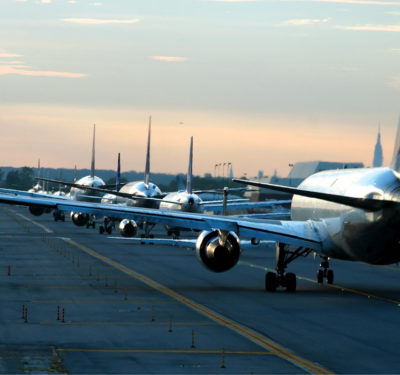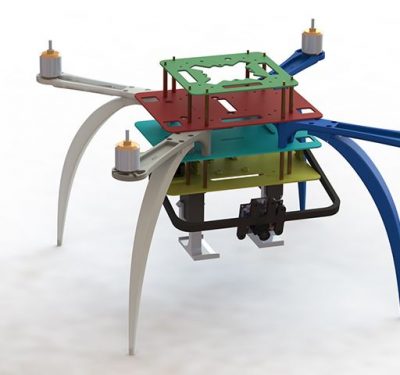
Case New Holland (CNH) has been evolving autonomous tractors since 2016.
Not so long ago, a just-in-time supply chain was all the rage. It was efficient, it saved money, and it took advantage of computer modeling and modern transportation networks. But it was already starting to crack when COVID-19 broke it.
“The biggest reason we have such a massive supply chain disruption in the U.S.,” said supply chain, logistics and strategy consultant Brittain Ladd, “is that in 2020 the entire continent did something that had never been done before: It voluntarily shut down. And it’s one thing to shut off the supply chain; it’s something else entirely to try and turn it back on.”
Amid port shut-downs, labor shortages, and disrupted shipping and delivery schedules, the food chain has proven especially vulnerable. “Food is much different than a supply chain that isn’t food-related,” Ladd pointed out from Texas, “especially when we’re talking about anything that’s perishable.”
Stephanie Casella, manager of strategic advocacy communications at the American Association of Port Authorities, noted that agricultural exporters, for example, need reliable time windows—which have been in short supply as ocean carrier schedules have fluctuated. “Sometimes they’ll just leave with empty containers, which is actually more profitable for them, so agriculture ends up losing out,” she said. Even as shut-in consumers have ordered more goods, she added, ships haven’t been able to unload when all the dock and offloading spaces are taken. This has been a threat for anyone shipping food with a shelf life.
At the same time, COVID aggravated existing underlying issues: labor shortages in farming and trucking; climate, fire and weather disruptions; and lack of a sufficient workforce capable of dealing with sophisticated automation. And as the Omicron variant continues to affect workers from processing plants to grocery stores, consumers continue to find gaps on store shelves and menus.
Clearly, new approaches are needed.
So, how can drones, unmanned operations and autonomy help, starting on the farm and ending on your table?
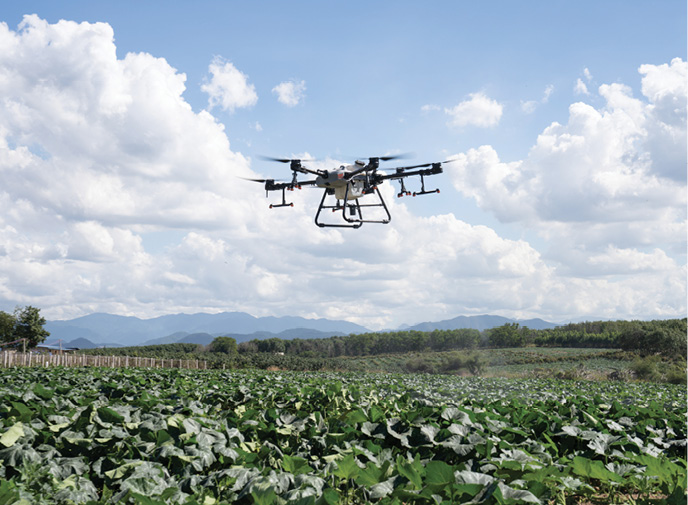
An Agri Spray Drones UAS working a field.
IN THE AIR: SCOUTING FOR CROP INFORMATION
Drones are taking market share from crop dusters and helicopters for aerial seeding and pesticide spraying, and it’s probably just in time. The average age of farmers is rising at the same time COVID is keeping help at home instead of in the field. In addition, foreign workers are being kept away due to COVID restrictions. Anything that lets a farmer do more with fewer people is valuable and desired.
Reese Mozer, CEO of Marlborough, Massachusetts-based American Robotics (AR), notes that, with a multispectral camera, a drone has the ability to tell if a crop is under stress or diseased, whether there are too many weeds or if the land is too dry. This can replace a COVID-sidelined person who would have to walk or ride through the field for inspections, and free healthy farmers for other tasks, or for a break from long days in the field.
Last year, AR became the first company to win FAA approval to operate its Scout System drones with no visible line of sight. In addition, AR was recently acquired by Ondas Holdings of Sunnyvale, California, which gave it additional network and software capability. “Automated drones are required for scalability,” Reese said, which helps the farmer make better use of the human resources he or she does have available.
Another player in the agricultural drone field is Agri Spray Drones of Centralia, Missouri.
“The supply chain issues are causing a shortage of inputs for crops, such as herbicides, fungicides and fertilizer,” founder Taylor Mooreland noted. “So, farmers need to use these inputs more efficiently. A sprayer/spreader drone provides greater accuracy in application. It also allows application when field conditions are not suitable to drive a tractor, such as after a heavy rain.”
Agri Spray uses the DJI Agras T30, and its application is getting noticed. “Our first year of sales, we estimate that our customers covered about 50,000 acres,” Mooreland said. But while sprayer drones have been around in other parts of the world, such as Asia, for more than a decade, the technology is just reaching the point that makes it useful for larger American farms. Also, the FAA is beginning a process to approve exemptions for bigger drones, which will lead to wider use.

ON THE GROUND: AUTONOMY FOR EFFICIENCY
Because farmers spend so much time in the field, the promise of a self-driving tractor can go a long way toward doing more with less.
One manufacturer pursuing this promise is Burr Ridge, Illinois-based Case New Holland (CNH), owner of brands such as Case IH, New Holland and Steyr. CNH was early on the scene, showing a concept autonomous tractor in 2016, and it continues to evolve the vehicle with a focus on precision operations such as end-of-row turning, grain threshing, and cleaning and accurate seed placement. The company currently has two autonomous tractor concept models: the Magnum by Case IH and the T8 NH Drive™ by New Holland Agriculture. Automation features are being added to save labor and increase efficiency.
Last year, CNH acquired Sioux Falls, South Dakota-based Raven Industries, which brought full autonomy to the table. CNH has carried out an autonomous tractor pilot focused on deep tillage for improved water infiltration and seedbed operations, using a small fleet of autonomous tractors pulling True-Tandem™ disk harrows or Case IH Ecolo-Tiger® disk rippers.
“We’re just starting to play the what-if game,” Dan Halliday, CNH senior director of product management said. “What if autonomy could do this? What if autonomy could do that? And the answer is, ‘It’s when, not if.’”
Dominic Walkes, director of strategic programs for Raven, added that perfecting technologies such as path and mission planning also furthers efficiency. Raven has launched new products under its OMNiDrive brand, a retrofit to make existing tractors, in fact, autonomous.
“OMNi lets a farmer monitor and operate a driverless tractor from the cab of a harvester so the harvester can offload on the go, then return the tractor and grain cart to an unloading area—all without a second driver,” Walkes said. Today, Raven is collaborating with Bolthouse Farms, one of the largest carrot producers in North America, on an autonomous tractor pilot program.
Farmers facing labor shortages will likely welcome the results of that test.
RIDING HERD: A LOWER-COST “DRONE COWBOY”
“In today’s world, skilled cowboys are not that easy to find,” BeeFree Agro co-founder and CEO Noam Azran noted.
While innovation and precision technology have changed most industries, raising free range livestock is something of an exception. Modern-day cowboys on horseback still exist all over the world, alongside the vehicles, choppers and dogs that help them. Israel’s BeeFree Agro is out to take that to the next level, using drones to save 50% in labor costs, including horse transportation, vehicle wear and tear, and new worker expenses. All while doing it faster than before.
Azran and co-founder COO Dvir Cohen were (literally) sitting around the campfire in Israel’s Upper Galilee when they decided to experiment with a drone. They began by using it to scout water troughs or cow locations, then discovered that cattle could respond to a drone much as they would to a horse.
They soon developed an algorithm that allowed the drone to move in a way cattle perceived as non-predatory, and they’ve been herding that way for more than 5 years.
They call their autonomous herding system “Joe”—after Azran’s herding dog. Using proprietary software and a DJI Enterprise Advanced or Matrice 300, Joe analyzes terrain and cow locations, and plans the best route to move the herd. Joe can then autonomously herd up to 1,000 head of cattle from pasture to pasture, collecting them for checkups, pregnancy tests and the like.
Using Joe has made the ranchers’ work more efficient. “We were able to cut down on our rotational employees by about 15% and cut our overall number of employees in half. What used to be a 4-hour horse ride, or a 3-hour ride on a four by four, is now done in 20 minutes using the drone.” This is especially important in Israel, which has been hit with waves of COVID shutdowns.
Right now, an operator is still involved so Azran can’t yet call the system fully autonomous. The two obstacles are cost and regulations. However, BeeFree is pilot-testing on two ranches in Israel, with an additional five sites starting imminently. Expansion to additional countries, including the U.S., is planned over 2022. Deployment will begin with small operations to maintain line of sight; for flying beyond that, BeeFree is looking to New Zealand and Australia.
“We have a few options in the pipeline for drones capable of 3-5 hours of flight time and a range of over 30 miles,” Azran said.
If any cowboys ride into the sunset, Joe will be ready.
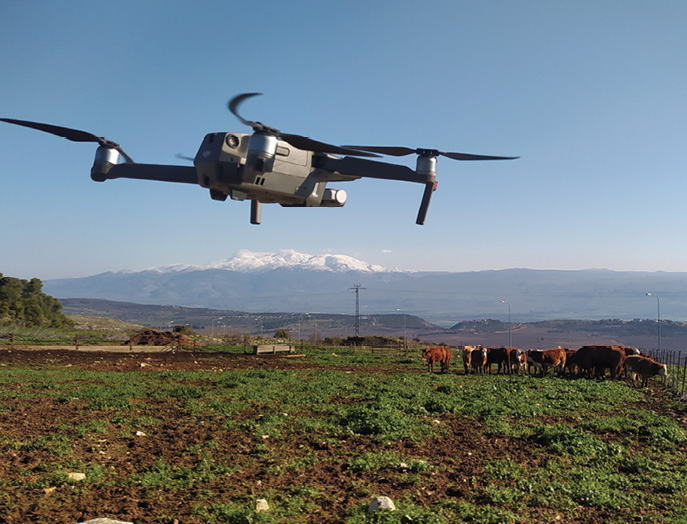
BeeFree’s herding drones save labor and money while working faster than human cowboys.
AT THE WATER’S EDGE: UNMANNED PORTS
Most global foods travel by sea, and automation has been a fast-growing feature of ports around the world even before COVID. As port authorities face a growing shortage of workers, it’s become even more important. While facilities are not fully autonomous, there are ports that are unmanned and operated remotely.
In 2015, major container shipper A. P. Moller-Maersk opened APM Terminals Maasvlakte II in Rotterdam, Europe’s largest seaport. The facility is fully automated, reported Marko Mihajic, senior press officer for the Copenhagen-based company—“which means there are no vessels or equipment of any kind driven or controlled by people anywhere on the terminal.”
Refrigerated containers, which are crucial to food transport, bring their own challenges. “There is a whole logistics for refrigerated containers because they need to be plugged in and might need to maintain conditions such as humidity. So, the way they’re loaded, unloaded and stored needs to be carefully planned,” Mihajic said.
While COVID has not (yet) led to changes in the systems, efficient operation remains crucial to keeping the supply chain operational.
ON THE ROAD: DRIVERLESS TRUCKS GAIN SPEED
Once food is grown, slaughtered or unloaded, it has to get somewhere over land. In the U.S., some 70% of food moves by truck. While their capabilities are still unfolding, driverless trucks are likely to become part of the food supply chain. Food Logistics magazine has predicted that broad application of autonomous technology is possible by 2024.
Even before the pandemic, the trucking industry faced the same labor shortages as agriculture, with the added dimension that trucker wages have declined with deregulation. The American Trucking Association estimates that the U.S. is short some 80,000 truck drivers, and that 90% of new drivers don’t last more than a year. All this was made worse with COVID, as driver testing and training stalled because of lockdowns. Similar shortages are evident in Europe and Asia.
Addressing that, several demonstration projects are underway, albeit with experienced drivers in the cabs, just in case.
Canadian autonomous trucking start-up NuPort Robotics opened in 2019, and bills itself as Canada’s first autonomous trucking company. The Toronto company, as Inside Logistics magazine reports, focuses on the short-haul niche of routes up to 25 kilometers, typically ending at a warehouse. Traditional trucks or drivers accompanying the vehicles will then take over the “last mile,” supervising loading, off-loading and customer interaction.
Supply chain and fleet management solutions company Ryder, headquartered in Bensenville, Illinois, has partnered with several companies offering self-driving software, including San Francisco’s Embark, Phoenix-area Alphabet subsidiary Waymo Via and San Diego’s TuSimple, which operates its own fleet of autonomous freight trucks in the southwest, with those experienced truck drivers currently riding along for safety. As Inside Unmanned Systems has reported, TuSimple is working with Lisle, Illinois-based Navistar to develop its own line of autonomous trucks, with production targeted for 2024. It also operates its own fleet of autonomous freight trucks in the southwest, albeit with experienced truck drivers riding along for safety.
Regarding the food chain, however, the development of autonomous trucks will not be without hurdles. NuPort CEO Raghavender Sahdev has flagged issues regarding cold chain development in particular. “Power consumption,” he told Food Logistics magazine, “is high with refrigerated trucks, and so autonomous systems will need efficient power management for sensor systems and computers.”
As they proliferate, driverless trucks must overcome regulations and safety concerns to fully integrate onto U.S. highways. As they do, they are likely to help alleviate lingering pandemic challenges and address permanent situations such as driver shortages.
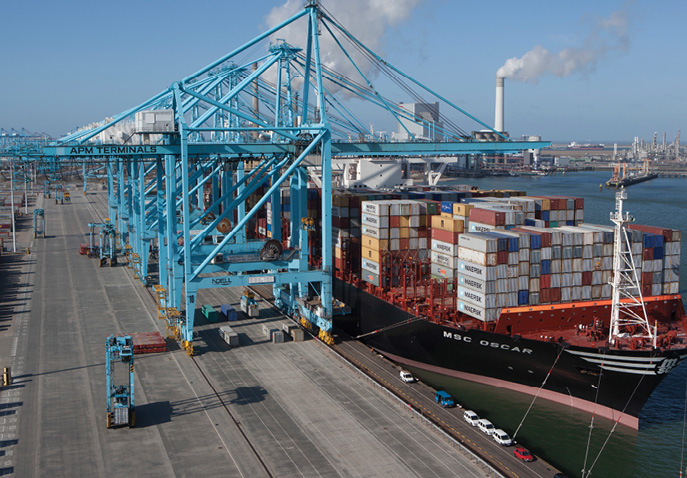
APM has brought autonomy to the Port of Rotterdam; Robots are visible on the left
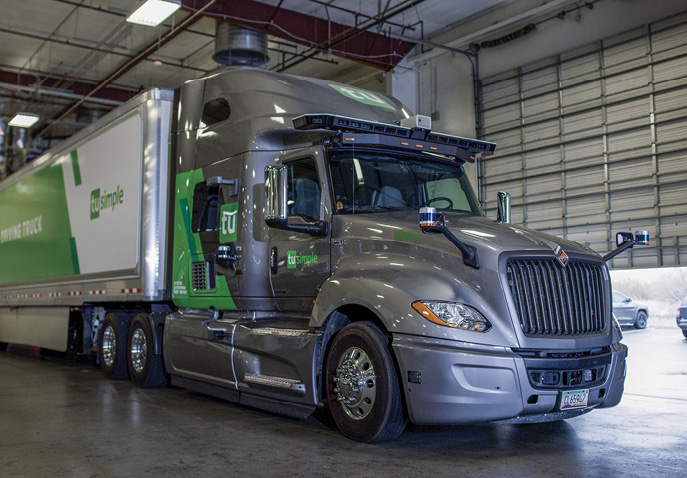
TuSimple is one of several carriers operating autonomous “middle-mile” runs.
ON TRACK: HEAVY LIFTING
A good deal of food—17%—travels by rail. Outside Chicago, in Joliet, Illinois, Omaha, Nebraska-based Union Pacific railroad will soon be testing artificial intelligence-powered cranes that can operate semi-autonomously, loading and unloading containers, including food containers, onto semis. Truck drivers will use the company’s UPGo mobile app to be assigned a transfer location, and then the crane will do the heavy lifting. These giant cranes are 75 feet tall and 250 feet wide, and operate over six tracks. While they can manage multiple work orders, priorities and lifting functions, they will stop once the container is over the track or truck transfer area; at this point, a remote human operator will supervise lowering the container to be sure it is done safely.
In addition to efficiency, the electric-powered cranes produce zero emissions and will eliminate the use of most diesel trucks. Because the whole unloading operation will involve fewer people, it is likely that containers holding food can move faster while avoiding the disruptions that come when workers get sick, thus minimizing spoilage and maximizing freshness of perishable edibles.
WAREHOUSES AND GROCERIES: DISRUPTION SPARKS AUTONOMY
Most food stops at a warehouse on its journey, where autonomous mobile robots (AMRs) or automated guided vehicles (AGVs) have made inroads as forklifts, pickers and sorting carts. This autonomous/automated market is expected to grow 16% between 2019 and 2025. Such automation cuts labor needs and makes the warehouse less vulnerable to pandemic-related absences and complications.
COVID has catapulted online grocery 5 years into the future in just a few months, according to Food Logistics. Along with other disruptors, this has prompted grocery stores leaders rethink their operations. One response has been the development of micro-fulfillment centers.
Next to its store in Westmont, Illinois, Albertson’s Jewel-Osco recently unveiled a micro-fulfillment center to handle online orders. Powered by Waltham, Massachusetts-based Takeoff Technology, groceries are ferried from inside a storage building and moved by robots and humans to where customers can pick up their orders, often in contactless processes. With many people still afraid of human interaction, this both adds to convenience and helps allay COVID fears.
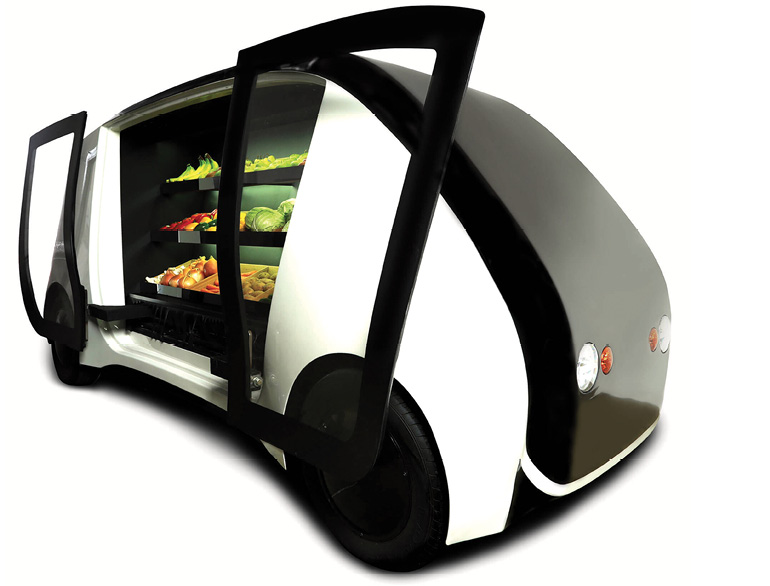
Customers unlock the Robomart pantry with an app; RFID tracks their purchases.
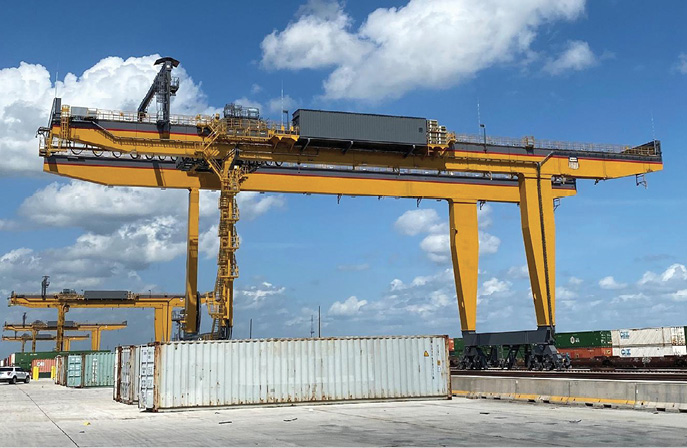
Autonomous cranes at the Union Pacific Railway Facility outside Chicago. Photos Courtesy of Robomart and Union Pacific.
SETTING THE TABLE: DRIVERLESS DELIVERY
COVID may have forever changed meal takeout and grocery delivery. People working from home are now acccustomed to having food show up on their doorstep, and this timesaving convenience is highly likely to continue even as COVID ebbs and flows.
In Tel Aviv, for example, a food delivery segment of Israel’s National Drone Initiative used drones operated by two companies to deliver sushi to a beach. In another demonstration, ice cream was delivered to customers in a park.
In Santa Monica, California, Robomart has pioneered a new form of automated vehicle delivery it calls Store. As co-founder Ali Ahmed described the platform, “A consumer uses the Robomart app to hail a store that literally comes to them and that they unlock with the Robocop app.” Robomart uses RFID to track what items the customer takes out.
Founded in 2017, the company debuted an unmanned version in 2019, but it’s operating with drivers “until regulation allows,” Ahmed said.
In San Francisco, another company, Tortoise, is pioneering an “electronic delivery cart.” Tortoise’s remote-controlled robot can hold up to 150 pounds of groceries and goods within two large storage boxes. When a customer places an e-commerce order, the retailer fills the boxes and sends the pickup-style robot to the customer’s home. Same-day delivery within 3 miles of a store or hub is promised.
Company co-founder Dmitry Shevelenko enumerated Tortoise’s founding principles: low speed comes before high speed; light mass comes before heavy mass; and remote controlled comes before autonomous when it comes to automation in the public sphere. These principles have been drafted to address customer concerns, allowing them to become accustomed to such service.
So, despite COVID’s disruption, drones, autonomy and a bit of innovation are keeping the food chain whole.


